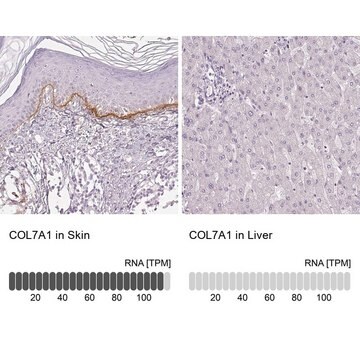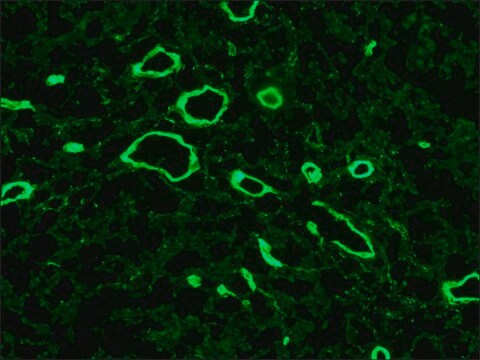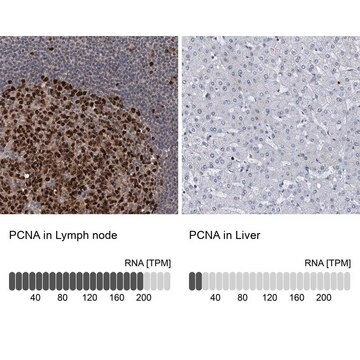MAB1378
Anti-Integrin α6 Antibody, clone NKI-GoH3
clone NKI-GoH3, Chemicon®, from rat
Synonym(s):
CD49f
Sign Into View Organizational & Contract Pricing
All Photos(1)
About This Item
UNSPSC Code:
12352203
eCl@ss:
32160702
NACRES:
NA.41
Recommended Products
biological source
rat
Quality Level
antibody form
purified immunoglobulin
antibody product type
primary antibodies
clone
NKI-GoH3, monoclonal
species reactivity
human, mouse
manufacturer/tradename
Chemicon®
technique(s)
flow cytometry: suitable
immunohistochemistry: suitable
isotype
IgG2a
NCBI accession no.
UniProt accession no.
shipped in
wet ice
target post-translational modification
unmodified
Gene Information
human ... ITGA6(3655)
Related Categories
General description
Integrins are a family of dimeric, transmembrane proteins that mediate cell-cell and extracellular matrix adhesion. Signals transduced by integrins play a role in many biological processes, including cell growth, differentiation, migration and apoptosis. The integrin family is composed of at least 15 alpha and 8 beta subunits that may form over twenty different alpha-beta non-covalently bound dimeric combinations on the cell surface. The alpha subunits all have some homology to each other, as do the beta subunits. Both of the subunits contribute to the binding of the ligand. Integrin alpha subunits contain seven weak sequence repeats in the N-terminal region, which may be important in ligand binding, and have been predicted to fold cooperatively into a single beta-propeller domain with seven beta-sheets. In normal tissue, Integrin alpha-6/beta-1 is a receptor for laminin on human platelets. Integrin alpha-6/beta-4 is a receptor for laminin in epithelial cells and it plays a critical structural role in the hemidesmosome. Various disease states involving epithelial cells have been shown to be associated with alterations in alpha 6 integrin-containing heterodimers.
Specificity
Directed against the Cdw49f-antigen, 120kDa, (GP Ic or VLA-6 alpha-chain), which can form distinct complexes with either the CD29-antigen (GP 11a or VLA beta-chain), resulting in the VLA-6 (alpha-6 beta-1) complex, which is expressed on human platelets, or with the beta-4 integrin resulting in the alpha-6 beta-4 complex which is expressed on various human epithelial cells. The monoclonal antibody reacts with platelets, megakaryocytes, T lymphocytes and common Acute Lymphoblastic Leukemia cells (alpha-6 beta-1). In immunohistology the monoclonal antibody reacts with epithelial cells of a variety of tissues, peripheral nerves, microvascular endothelial cells, placenta cyto- and syncytotrophoblasts. Platelet VL-6 functions as a laminin receptor and platelet adhesion to laminin is inhibited by GoH3.
Immunogen
Mammary tumor cells from BALB/c mice.
Application
Detect Integrin α6 using this Anti-Integrin α6 Antibody, clone NKI-GoH3 validated for use in FC, IH.
Flow cytometry: 1:10
Immunohistology on frozen tissue sections: 1:25-1:50
Immunoprecipitation (Sonnenberg, et al. 1990)
Inhibition of laminin binding:40μg/ml.
Optimal working dilutions must be determined by end user.
Immunohistology on frozen tissue sections: 1:25-1:50
Immunoprecipitation (Sonnenberg, et al. 1990)
Inhibition of laminin binding:40μg/ml.
Optimal working dilutions must be determined by end user.
Research Category
Cell Structure
Cell Structure
Research Sub Category
Integrins
Integrins
Physical form
Format: Purified
Protein A Purified mouse immunoglobulin in 20 mM sodium phosphate, 250 mM NaCl, pH. 7.6, with 0.1% sodium azide as a preservative.
Protein A purified
Storage and Stability
Maintain for 1 year at 2–8°C from date of shipment. For maximum recovery of product, centrifuge the original vial after thawing and prior to removing the cap.
Analysis Note
Control
Human intestine tissue
Human intestine tissue
Other Notes
Concentration: Please refer to the Certificate of Analysis for the lot-specific concentration.
Legal Information
CHEMICON is a registered trademark of Merck KGaA, Darmstadt, Germany
Disclaimer
Unless otherwise stated in our catalog or other company documentation accompanying the product(s), our products are intended for research use only and are not to be used for any other purpose, which includes but is not limited to, unauthorized commercial uses, in vitro diagnostic uses, ex vivo or in vivo therapeutic uses or any type of consumption or application to humans or animals.
Not finding the right product?
Try our Product Selector Tool.
Storage Class Code
10 - Combustible liquids
WGK
WGK 2
Certificates of Analysis (COA)
Search for Certificates of Analysis (COA) by entering the products Lot/Batch Number. Lot and Batch Numbers can be found on a product’s label following the words ‘Lot’ or ‘Batch’.
Already Own This Product?
Find documentation for the products that you have recently purchased in the Document Library.
Somatic correction of junctional epidermolysis bullosa by a highly recombinogenic AAV variant.
Melo, SP; Lisowski, L; Bashkirova, E; Zhen, HH; Chu, K; Keene, DR; Marinkovich, MP; Kay, MA; Oro, AE
Molecular Therapy null
D S Whitlon et al.
Neuroscience, 138(2), 653-662 (2006-01-18)
We have systematically characterized neuronal survival and growth in cultures derived from newborn/postnatal day 1 mouse cochlea. Dissociated cultures of the cochlear spiral ganglion provide an experimental environment in which to examine molecular mechanisms of survival, development and physiology of
In vivo restoration of laminin 5 beta 3 expression and function in junctional epidermolysis bullosa.
P B Robbins et al.
Proceedings of the National Academy of Sciences of the United States of America, 98(9), 5193-5198 (2001-04-11)
The blistering disorder, lethal junctional epidermolysis bullosa (JEB), can result from mutations in the LAMB3 gene, which encodes laminin 5 beta3 (beta3). Appropriate expression of LAMbeta3 in JEB skin tissue could potentially ameliorate the symptoms of the underlying disease. To
A complex of platelet glycoproteins Ic and IIa identified by a rat monoclonal antibody.
Sonnenberg, A, et al.
The Journal of Biological Chemistry, 262, 10376-10383 (1987)
Identification and characterization of a novel antigen complex on mouse mammary tumor cells using a monoclonal antibody against platelet glycoprotein Ic.
Sonnenberg, A, et al.
The Journal of Biological Chemistry, 263, 14030-14038 (1988)
Our team of scientists has experience in all areas of research including Life Science, Material Science, Chemical Synthesis, Chromatography, Analytical and many others.
Contact Technical Service







